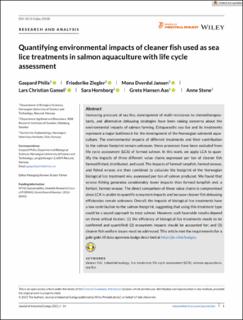Quantifying environmental impacts of cleaner fish used as sea lice treatments in salmon aquaculture with life cycle assessment
| dc.contributor.author | Ziegler, Friederike | |
| dc.contributor.author | Jansen, Mona Dverdal | |
| dc.contributor.author | Gansel, Lars Christian | |
| dc.contributor.author | Hornborg, Sara | |
| dc.contributor.author | Aas, Grete Hansen | |
| dc.contributor.author | Stene, Anne | |
| dc.date.accessioned | 2021-04-26T12:33:09Z | |
| dc.date.available | 2021-04-26T12:33:09Z | |
| dc.date.created | 2021-03-25T10:57:57Z | |
| dc.date.issued | 2021 | |
| dc.identifier.issn | 1088-1980 | |
| dc.identifier.uri | https://hdl.handle.net/11250/2739640 | |
| dc.description.abstract | Increasing pressure of sea lice, development of multi‐resistance to chemotherapeutants, and alternative delousing strategies have been raising concerns about the environmental impacts of salmon farming. Ectoparasitic sea lice and its treatments represent a major bottleneck for the development of the Norwegian salmonid aquaculture. The environmental impacts of different treatments and their contribution to the salmon footprint remain unknown; these processes have been excluded from life cycle assessment (LCA) of farmed salmon. In this work, we apply LCA to quantify the impacts of three different value chains expressed per ton of cleaner fish farmed/fished, distributed, and used. The impacts of farmed lumpfish, farmed wrasse, and fished wrasse are then combined to calculate the footprint of the Norwegian biological lice treatment mix, expressed per ton of salmon produced. We found that wrasse fishing generates considerably lower impacts than farmed lumpfish and, a fortiori, farmed wrasse. The direct comparison of these value chains is compromised since LCA is unable to quantify ecosystem impacts and because cleaner fish delousing efficiencies remain unknown. Overall, the impacts of biological lice treatments have a low contribution to the salmon footprint, suggesting that using this treatment type could be a sound approach to treat salmon. However, such favorable results depend on three critical factors: (1) the efficiency of biological lice treatments needs to be confirmed and quantified; (2) ecosystem impacts should be accounted for; and (3) cleaner fish welfare issues must be addressed. | en_US |
| dc.language.iso | eng | en_US |
| dc.publisher | Wiley | en_US |
| dc.rights | Navngivelse 4.0 Internasjonal | * |
| dc.rights.uri | http://creativecommons.org/licenses/by/4.0/deed.no | * |
| dc.subject | Industriell økologi | en_US |
| dc.subject | Industrial Ecology | en_US |
| dc.subject | Rensefisk | en_US |
| dc.subject | Cleanerfish | en_US |
| dc.subject | LCA | en_US |
| dc.subject | LCA | en_US |
| dc.subject | Lakseoppdrett | en_US |
| dc.subject | Salmon breeding | en_US |
| dc.subject | Livssyklustenkning | en_US |
| dc.subject | Life-cycle thinking | en_US |
| dc.subject | Lakselus | en_US |
| dc.subject | Salmon louse | en_US |
| dc.title | Quantifying environmental impacts of cleaner fish used as sea lice treatments in salmon aquaculture with life cycle assessment | en_US |
| dc.type | Peer reviewed | en_US |
| dc.type | Journal article | en_US |
| dc.description.version | publishedVersion | en_US |
| dc.subject.nsi | VDP::Miljøteknologi: 610 | en_US |
| dc.subject.nsi | VDP::Environmental engineering: 610 | en_US |
| dc.subject.nsi | VDP::Miljøteknologi: 610 | en_US |
| dc.subject.nsi | VDP::Environmental engineering: 610 | en_US |
| dc.source.journal | Journal of Industrial Ecology | en_US |
| dc.identifier.doi | 10.1111/jiec.13118 | |
| dc.identifier.cristin | 1901629 | |
| cristin.ispublished | true | |
| cristin.fulltext | original | |
| cristin.qualitycode | 2 |

